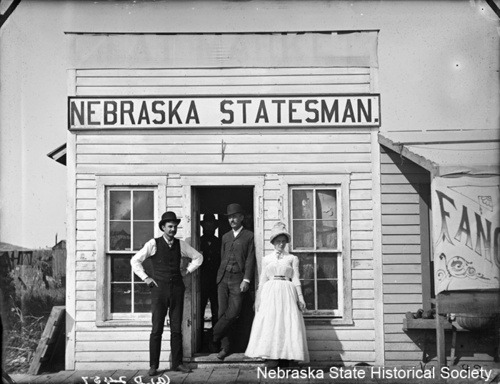Perhaps the most memorable thing about the Nebraska Statesman, published in Broken Bow from 1885 through the end of 1890, was Solomon D. Butcher’s arresting photograph, taken in 1886 when the town was booming. The Statesman may not have been one of Nebraska’s most notable newspapers, but because of this iconic photograph, it is one of the most visually recognizable. What’s the story behind the picture and the people (not identified by Butcher) who stare confidently at the viewer from the entry and the board sidewalk in front of the newspaper office across a span of 125 years? Broken Bow was platted by Jesse Gandy in 1882, only three years before the birth of the Statesman, and grew rapidly. It won the Custer County seat from Westerville that year and in 1883, the county fair. By the spring of 1884 it was incorporated, and there were rumors of a railroad. A Burlington and Missouri River Railroad survey was made in 1885, and the first train arrived in August 1886. The Omaha Daily Bee in September credited the town with a population of one thousand, eight general stores, four drug stores, three hardware stores, three hotels, and three well edited newspapers.

The two Broken Bow newspapers sharing the journalistic field with the Statesman in 1886 were the Custer County Leader and the Custer County Republican. The Statesman, established in late 1885 as a “red hot Democratic paper” by John S. Dellinger and Robert E. Martin, prospered briefly because it enjoyed the patronage of the land office at Grand Island. First located on the south side of Broken Bow, it moved to the railroad addition on the north side of the tracks after the train arrived in town. Dellinger and Martin established a branch paper at Mason City, the Mason City Transcript, in June 1886. The pair later dissolved their partnership, with Martin retaining the Statesman. In 1888 the Statesman, edited by Martin, claimed a circulation of 1,100 with an annual subscription rate of $1.50. In June it was consolidated with another local paper, the Broken Bow Times. In the only surviving issue-that of December 6, 1888-the four pages of the Statesman carried little local news, but a great deal of advertising and many final proof notices from the Grand Island and North Platte land offices.” The newspaper ceased publication when editor and publisher Martin left Broken Bow in early January of 1891. A. Z. Lazenby purchased the plant of the defunct Statesman later that year in November and hauled it to Merna, where he established the short-lived Merna Reporter. Although the figures in Butcher’s 1886 photo of the office of the Nebraska Statesman (including the young woman, probably an employee, holding a typestick) are not identified, Dellinger and Martin may be among them. Martin, described by Butcher in his history of Custer County as “an ex-Confederate soldier and forcible writer,” was a native of Missouri. Born April 26, 1841, he served with the Fifth Missouri Infantry, Company H., during the Civil War, attaining the rank of sergeant. The entire essay written by Patricia C.Gaster appears in the Fall 2011 issue.



